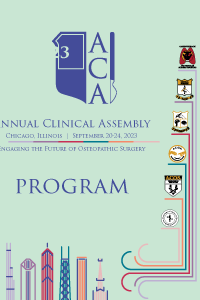General Surgery
Analysis of National Rates of Organ Recovery and Transplantation Among Brain Death Donors and Circulatory Death Donors
Location: Grandball Room 1-2
- ZL
Zoe Leuthner, MS
Alabama College of Osteopathic Medicine
Florence, Alabama, United States
Primary Presenter(s)
Introduction/Purpose: There are currently over 103,000 candidates awaiting organ donation, with greater than 10% having been waiting for 5 years or more. The vast majority of transplanted organs are obtained from deceased donors. The number of organs obtained from donation after circulatory death (DCD) donors has been increasing more rapidly in recent years compared to the number obtained from donation after brain death (DBD) donors, although the use of DCD organs has drawn some ethical debate. Here, we analyze the success rate of organs transplanted as a proportion of total organs recovered among DCD and DBD donors.
Methods or Case Description: Data was collected from the Organ Transplantation and Procurement Network. Data was collected for the number of organs recovered and the number of organs transplanted for DBD and DCD donors among the four most commonly transplanted organs: kidney, liver, heart, and lung. Proportions of organs transplanted from those recovered were compared for DBD and DCD donors between the years of 2002 and 2022. A Mann-Kendall test was performed to analyze trend and directionality for each group.
Outcomes: From 2002 to 2022, the percentage of total transplanted organs obtained from DCD donors increased from 1.9% to 23.3% for kidneys, from 1.5% to 10.7% for livers, from 0% to 8.3% for hearts, and from 0% to 7.8% for lungs. Success rates for proportion of organs transplanted out of those recovered showed a negative trend for DBD kidneys (p< 0.0001), DBD livers (p< 0.05), DBD lungs (p=0.001), and DCD lungs (p=0.018), with no groups showing positive trends for the years of the study. No significant trend was noted for the proportion of organs transplanted out of those recovered for DCD kidneys, DCD livers, DBD hearts or DCD hearts. In 2022, the proportion of organs transplanted of those recovered was highest for DBD hearts, at 0.99, and was lowest for DCD kidneys, at 0.66.
Conclusion: Organ donation is increasing among DCD donors, which may lessen some of the discrepancy between need and availability of transplanted organs, although it still accounts for a small percentage of total organ donations. As the number of both DBD and DCD organ transplantations continue to grow, it will be imperative to analyze the success rate of transplanted organs among those recovered. This will be especially critical as new techniques in organ transplantation are developed and ethical debate continues to surround criteria for death and organ donation eligibility.
Methods or Case Description: Data was collected from the Organ Transplantation and Procurement Network. Data was collected for the number of organs recovered and the number of organs transplanted for DBD and DCD donors among the four most commonly transplanted organs: kidney, liver, heart, and lung. Proportions of organs transplanted from those recovered were compared for DBD and DCD donors between the years of 2002 and 2022. A Mann-Kendall test was performed to analyze trend and directionality for each group.
Outcomes: From 2002 to 2022, the percentage of total transplanted organs obtained from DCD donors increased from 1.9% to 23.3% for kidneys, from 1.5% to 10.7% for livers, from 0% to 8.3% for hearts, and from 0% to 7.8% for lungs. Success rates for proportion of organs transplanted out of those recovered showed a negative trend for DBD kidneys (p< 0.0001), DBD livers (p< 0.05), DBD lungs (p=0.001), and DCD lungs (p=0.018), with no groups showing positive trends for the years of the study. No significant trend was noted for the proportion of organs transplanted out of those recovered for DCD kidneys, DCD livers, DBD hearts or DCD hearts. In 2022, the proportion of organs transplanted of those recovered was highest for DBD hearts, at 0.99, and was lowest for DCD kidneys, at 0.66.
Conclusion: Organ donation is increasing among DCD donors, which may lessen some of the discrepancy between need and availability of transplanted organs, although it still accounts for a small percentage of total organ donations. As the number of both DBD and DCD organ transplantations continue to grow, it will be imperative to analyze the success rate of transplanted organs among those recovered. This will be especially critical as new techniques in organ transplantation are developed and ethical debate continues to surround criteria for death and organ donation eligibility.

